This usually leads to you asking yourself two questions:
- How do I choose the best ones?
- How will I even have time to filter through that many applications?
In this post, you’ll learn how we set up a process to answer these questions.
Most job listings tell applicants to email the hiring manager their cover letter and resume. That works well when looking for full-time hires but not for freelance positions because they often attract hundreds or thousands of applicants.
There’s just no way you can review that many resumes without losing it. As a result, suitable applicants often slip through the net and you miss out on great writers.
One way to solve this problem is to have all applicants apply through a Google Form.
Here are two reasons why this makes sense:
- It helps you vet applicants fast and efficiently – Google Forms funnels applicants into a Google Sheet, so you can review all applicants there instead of sifting through emails.
- It allows you to test writers’ skills and knowledge at scale – You can easily ask questions designed to judge applicants’ knowledge, skills, and experience with the topic at hand.
In terms of what you should ask applicants, I recommend a mix of multiple-choice questions and ones with short answers. Multiple-choice questions help gauge knowledge and experience, whereas “short answer” questions allow you to judge writing ability.
Here’s one of our multiple-choice questions:
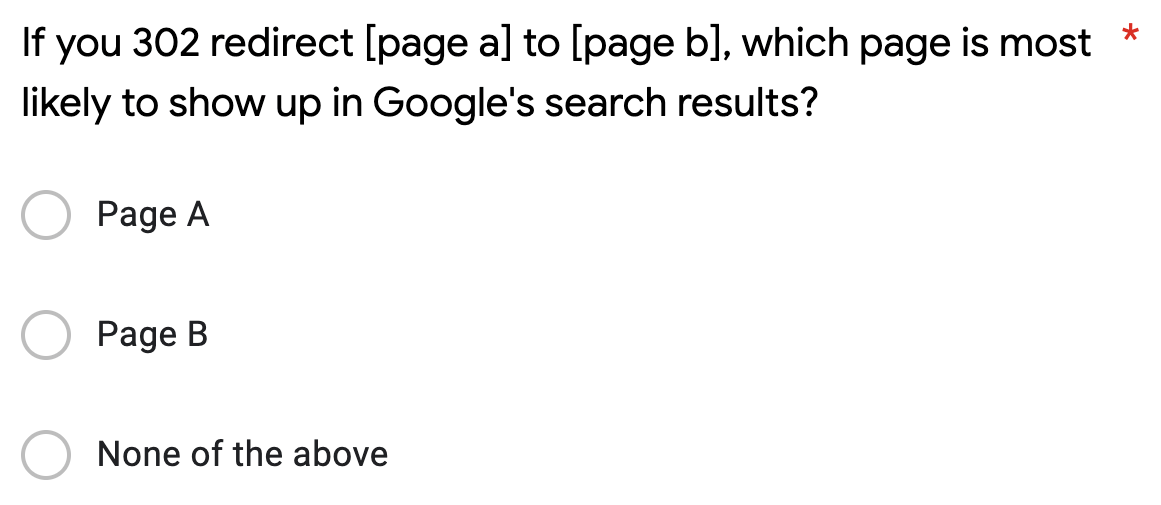
The answer to this question is something that we expect most experienced SEOs to know. But it may trip up those with less experience.
Here’s an example of a “short answer” question:

We designed this question to help us judge the applicant’s ability to explain things succinctly and accurately.
If you’re curious about our application form, here it is.
Only a handful of these questions are for vetting purposes; the rest are to get basic details like their names, email addresses, Twitter handles, etc. It’s essential to ask for these details, as it’s the only way to get them when applicants aren’t applying by email.
You now need to attract candidates to your application form, which you can do by creating a job listing and posting everywhere you can.
Here are the four things you need to explain:
- What you’re looking for – Keep it short. Tell applicants what the position entails.
- What skills you require – List everything you expect in applicants.
- Who you are – Give some details about your company. (Keep it short; don’t bore people.)
- How to apply – Send people to your application form.
There are plenty of job boards where you can submit your listing. We posted to ProBlogger, Swipe Files Job Board (prev. Hey Marketers), our careers page, and a few others.

We also posted in a few Slack and Facebook groups.
Given that every applicant goes through the same process, the more places you can post your job listing, the better.
Every aspect of the vetting process takes place in the Google Sheet. This makes life super easy, as everything is in one place. I recommend splitting the process into automated and manual vetting to make things as quick and efficient as possible.
Automated vetting
Here, the idea is to disqualify applicants who don’t fit the bill, give a preliminary score to the remaining ones, and clean up the sheet to make manual vetting as quick as possible. Here’s how to do it in three steps.
A. Disqualify
There’s no point wasting time reviewing applications from folks who can’t follow basic rules or don’t meet basic criteria. So it pays to disqualify them automatically. The beauty of Google Sheets is that you can do this easily with filters and formulas.
You’ll recall that we asked all applicants to define two terms in under 50 words. As we wanted to disqualify those who exceeded the allowed word count, we added two additional columns with formulas to count the number of words in each definition.
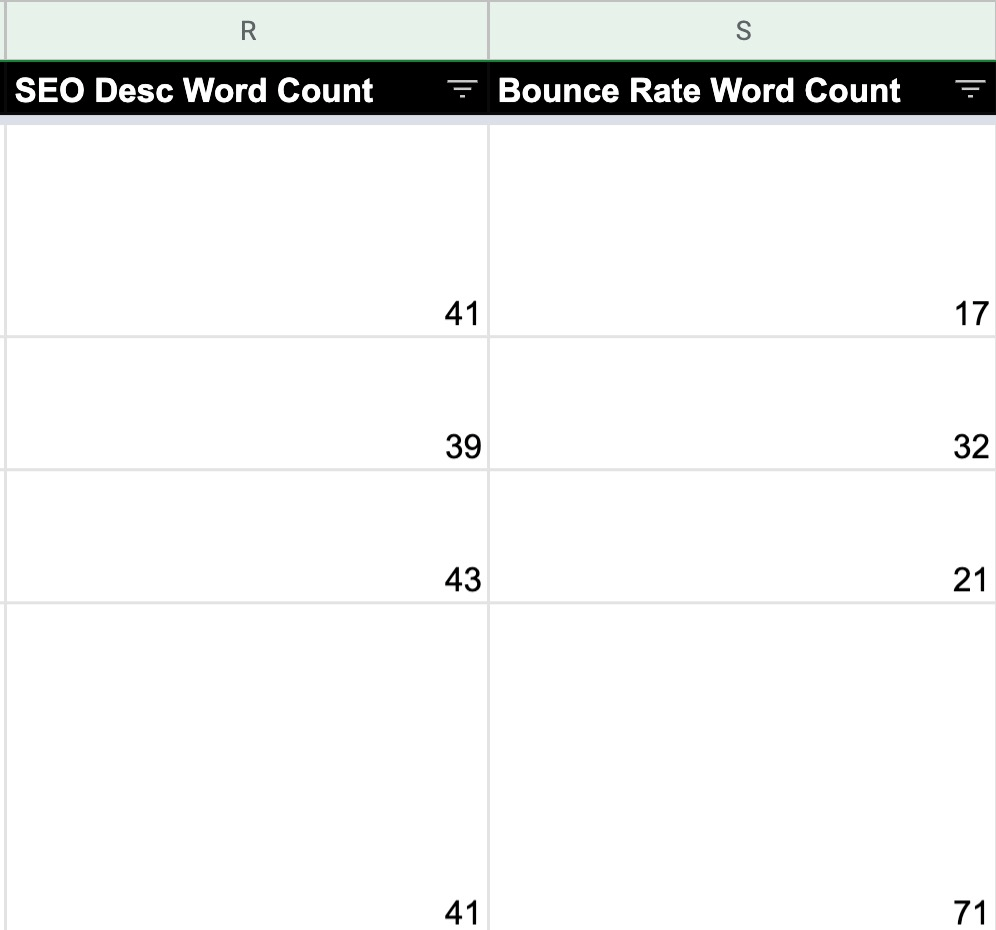
Then we filtered to exclude rows where the definitions were above 50 words.

We then filtered for a few more criteria:
- Rate per 1,000 words – We excluded anyone who didn’t put 10–1,000. (This was primarily to exclude applicants who couldn’t follow instructions and gave a price per word.)
- Years of experience in SEO – We excluded anyone with “<1” year of experience.
- Have you ever used Ahrefs before? – We excluded those who answered “no.”
B. Score
Next, you want to give each applicant a preliminary score to get a better sense of their knowledge and experience at a glance.
To do this, we created a formula that checked their answers to our multiple-choice questions, their Ahrefs experience, and whether they still had an active Ahrefs subscription. The result was a score between 0 and 5.
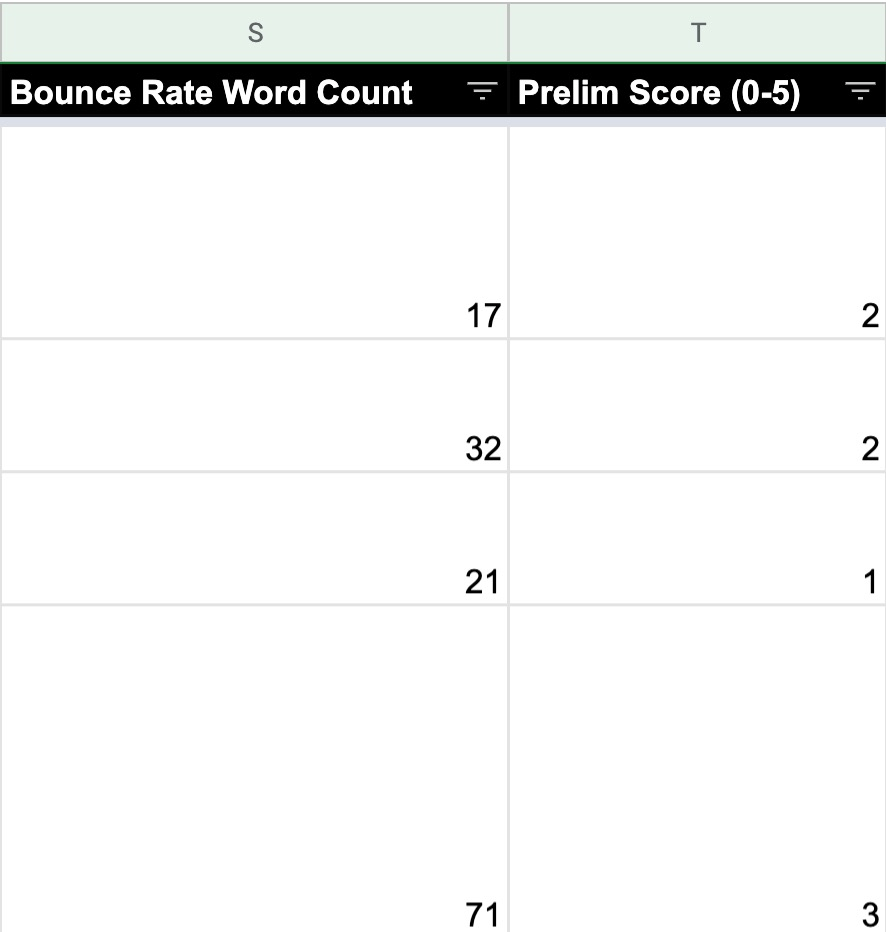
C. Simplify
Even with the filters and scores in place, your sheet will be overwhelming because it contains so much data. So it’s worth hiding columns you don’t need for the vetting process, such as applicants’ names and email addresses. This also helps to eliminate potential biases.
For us, we added conditional formatting to our preliminary score to make eyeballing the quality of each applicant easier.
Here’s what we ended up with:
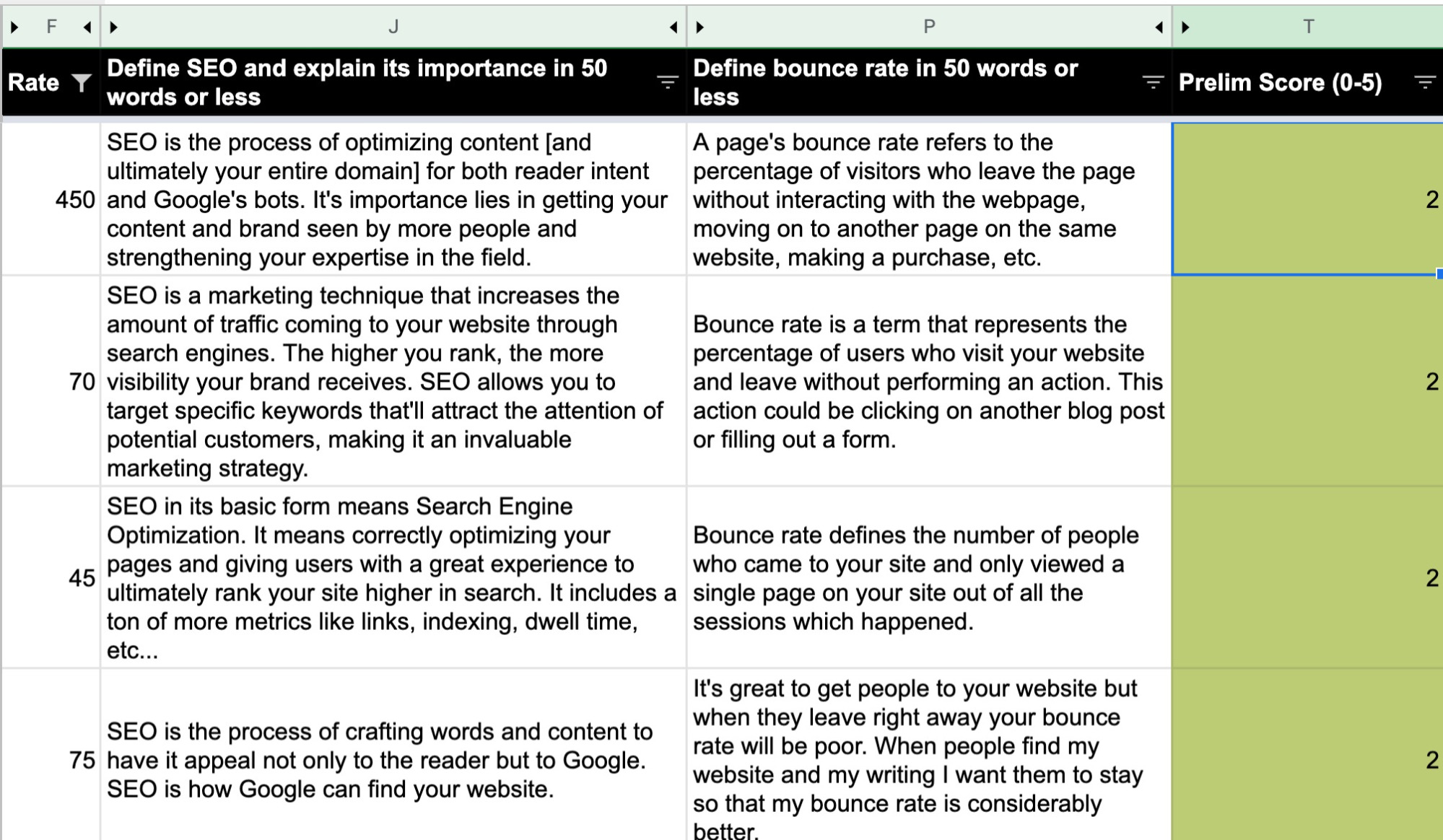
Manual vetting
We skimmed applicants’ preliminary scores and definitions to decide whether they should progress to the next stage of the process. Each applicant took no more than a few seconds, allowing us to vet over 100 applicants per hour.
For example, it only took a second to decide not to continue with this applicant because they defined SEM rather than SEO.

For the applicant below, on the other hand, we could tell pretty quickly that it’d be worth giving them a shot. Both of their definitions were accurate and well written, and they scored well on our multiple-choice questions:

To track our decision for each applicant, we added one final column:
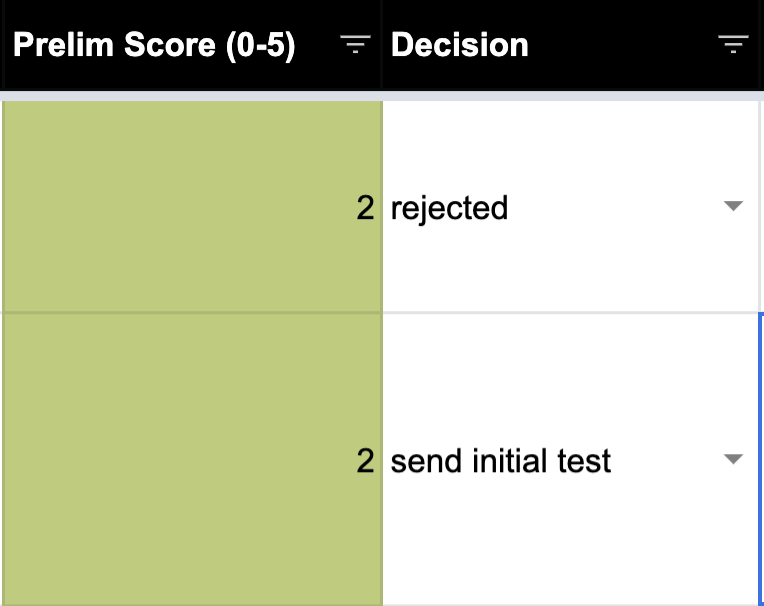
Most people test writers by having them write a test article from a content brief. We do the same but don’t send unique briefs to each applicant. We send them all the same brief.
Here are three reasons why we recommend this:
- It’s easier to grade their work – You can create a checklist to score writers on the same criteria.
- It’s quicker – You don’t have to create a new content brief for each writer.
- It can be automated – You can set up systems to send the brief to writers when they hit this stage.
Let’s look at how to ensure tests run smoothly and efficiently.
A. Explain the deal and get their details
For applicants who pass our initial vetting process, we need to explain the deal for the test article and get their details. We created a template in Gmail for this.
It explains that we:
- Want to offer them a paid test article.
- Pay a flat fee per test article (and how much).
- Send the same brief to every applicant and that their article won’t be published.
- Own all the work they produce for us.
- Pay invoices at the end of the month.
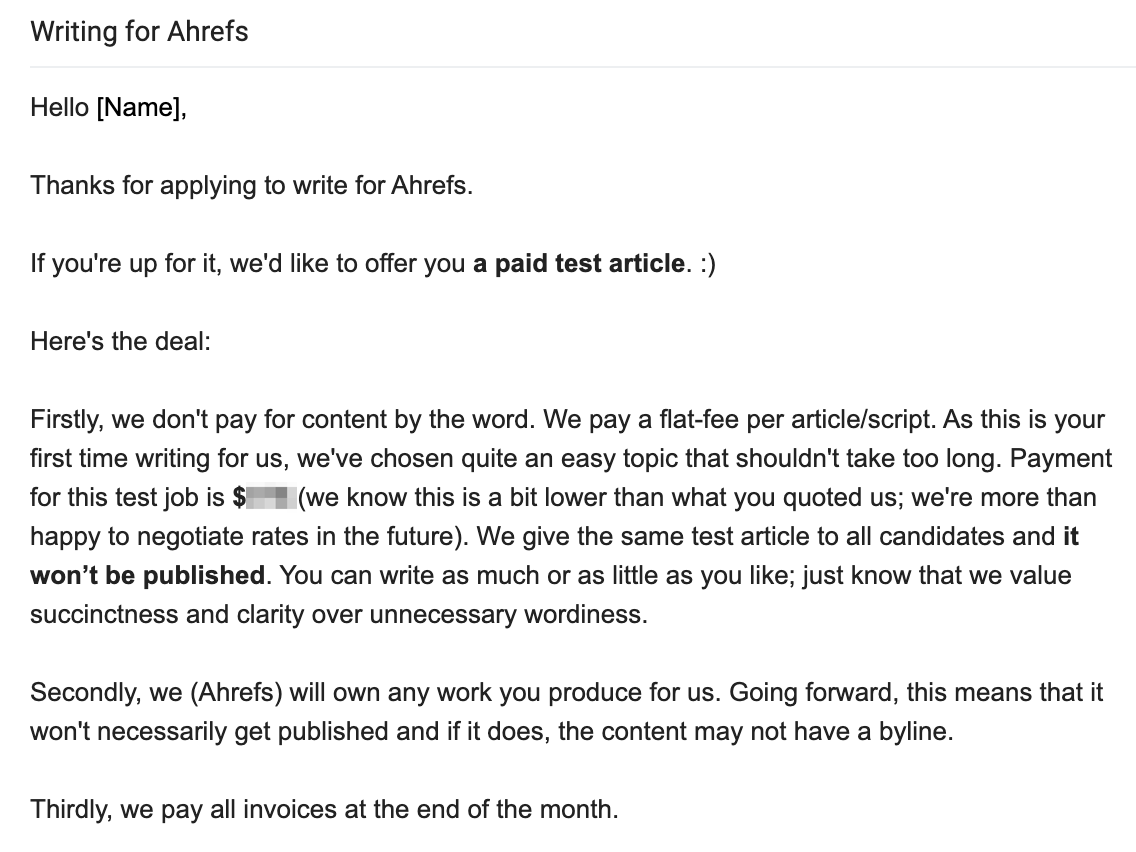
That may seem like information overload, but it’s best to make sure everyone’s on the same page from the beginning.
Our email ends with a link to a Google Form asking for their invoice email address (this is often different from the one they use daily) and how they want to be paid.

B. Send the content brief for the test
We show a confirmation message when an applicant submits the Google Form in the previous step. It links them to a Google Doc with the content brief for the test article.
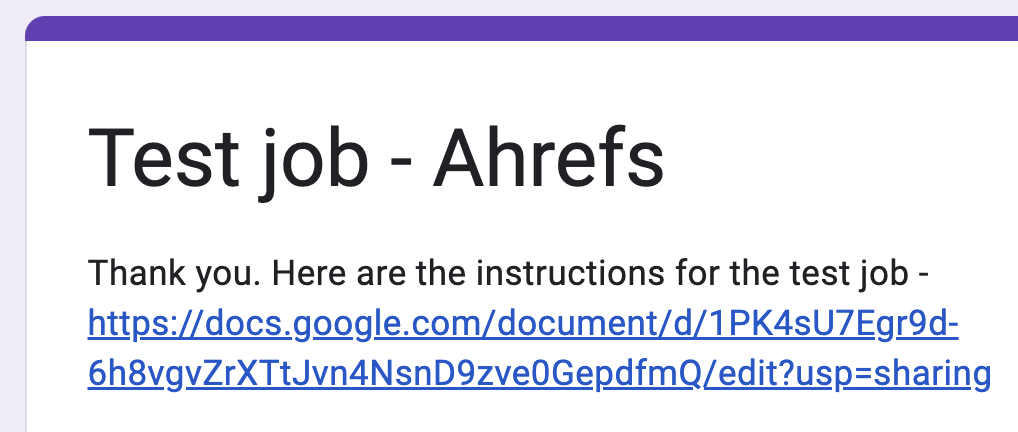
Here’s what that looks like:
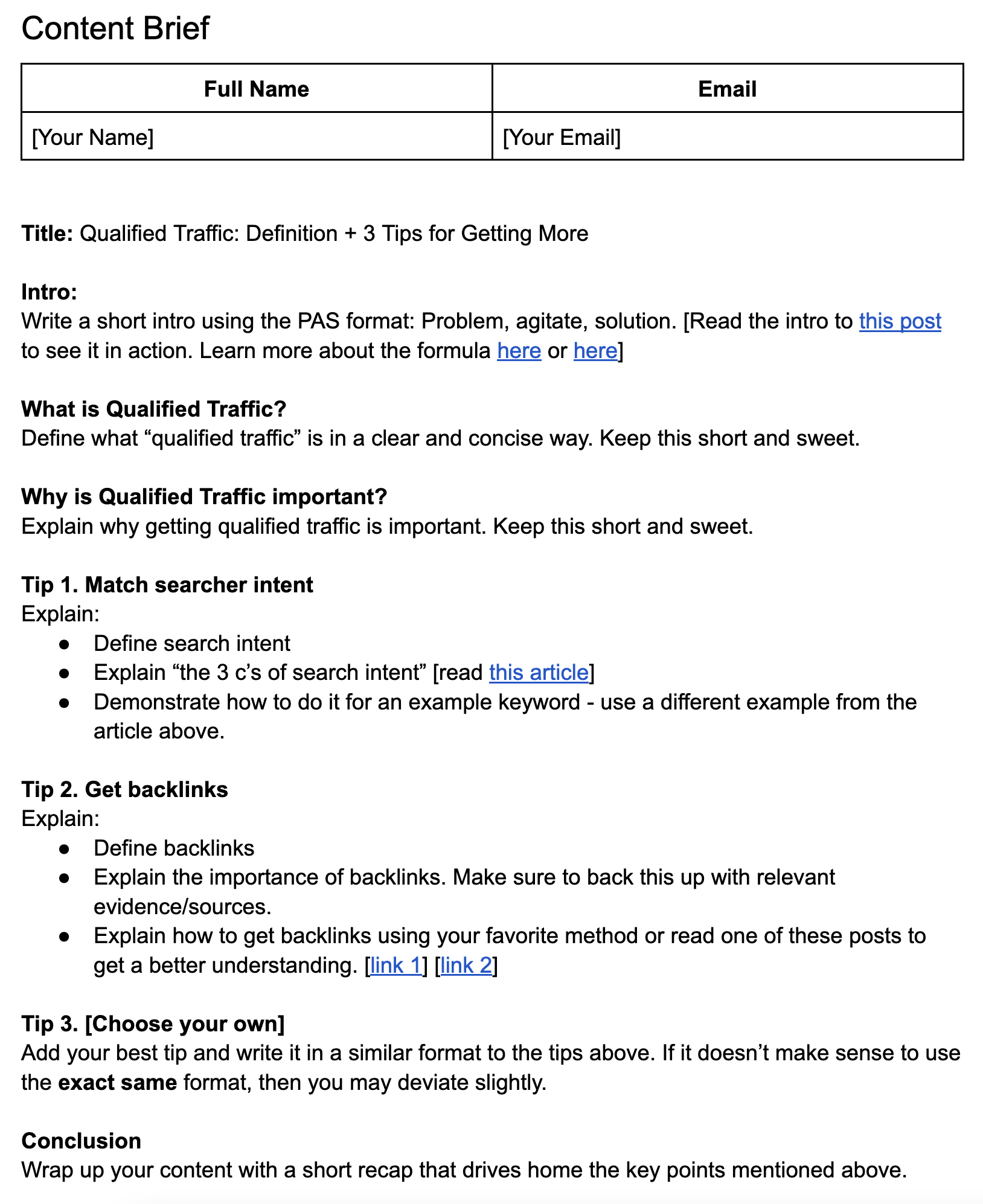
The document also contains instructions that tell the applicant to:
- Make a copy of the document.
- Write as much or as little as they like (no word count quotas).
- Email us the test article and invoice us when they’re done.
- Read our content guidelines before they start writing.
I recommend everyone create content guidelines when working with freelance writers. We link to ours in the doc. It explains what we expect regarding style and content.
Here are a couple of excerpts:
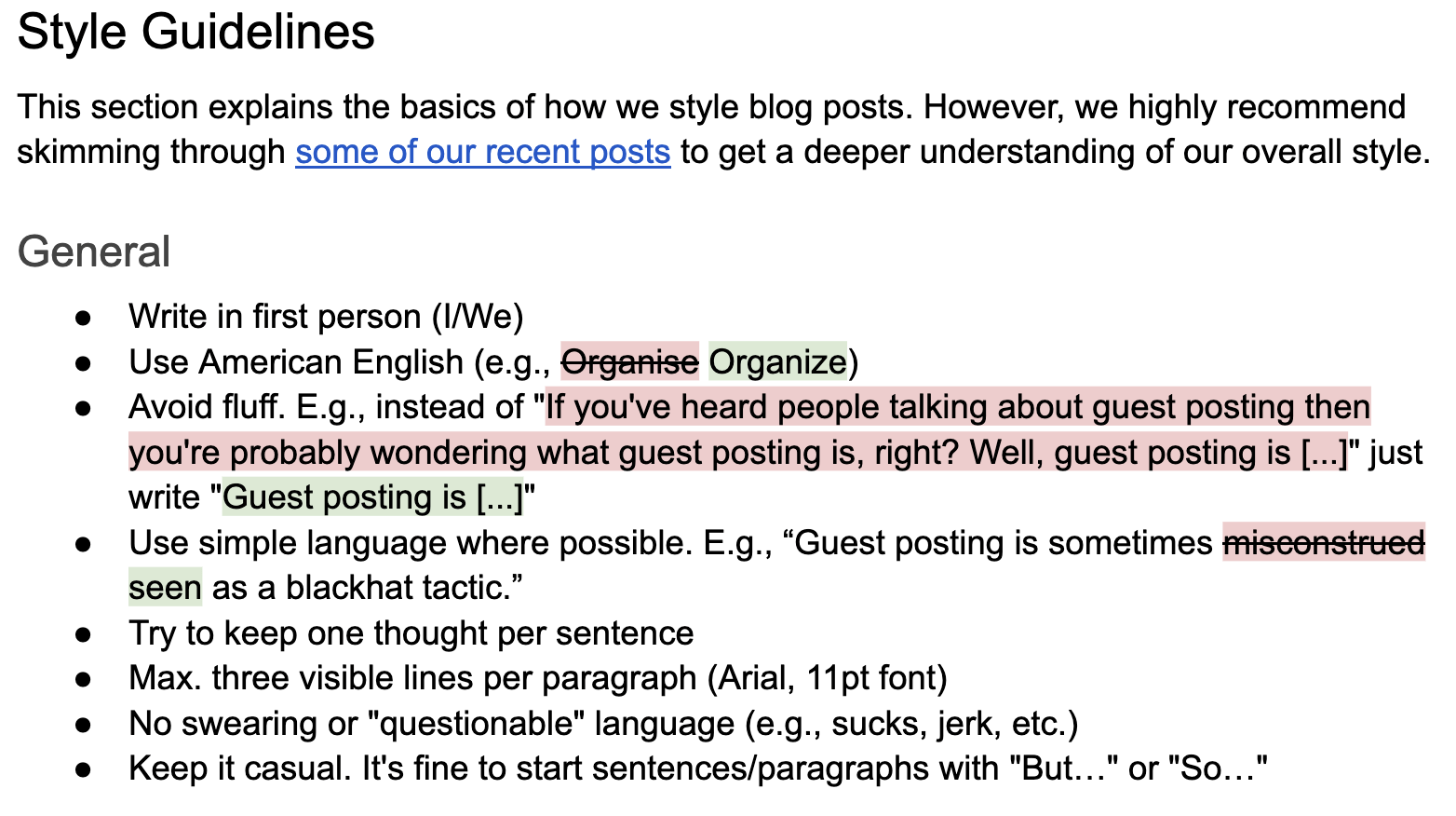
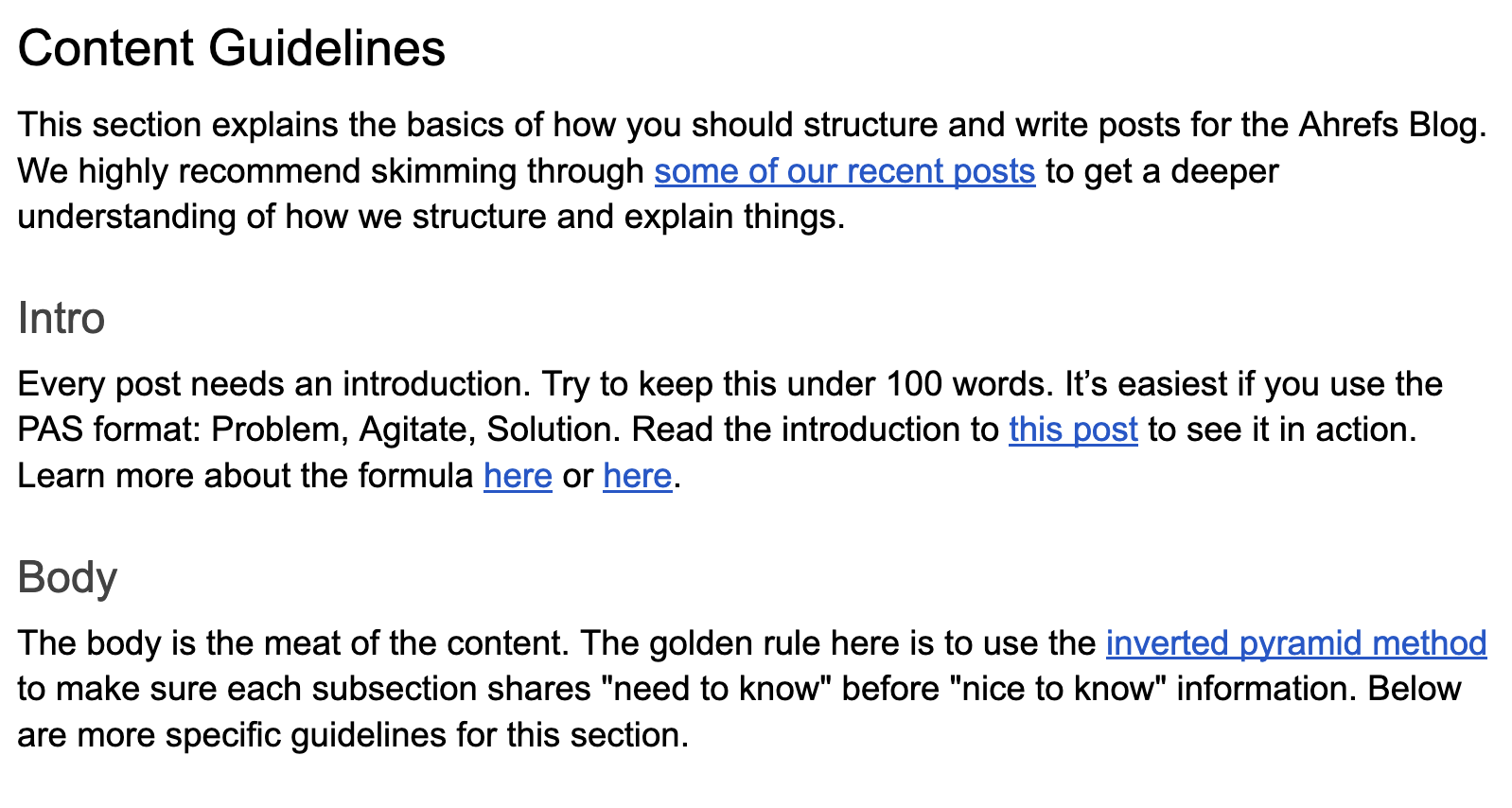
C. Review their content
Given that you’ll be testing a few writers, you need a fair and consistent way to judge their relative quality. For this, we created a checklist to review and score their efforts quickly.
Here’s an excerpt from our checklist:
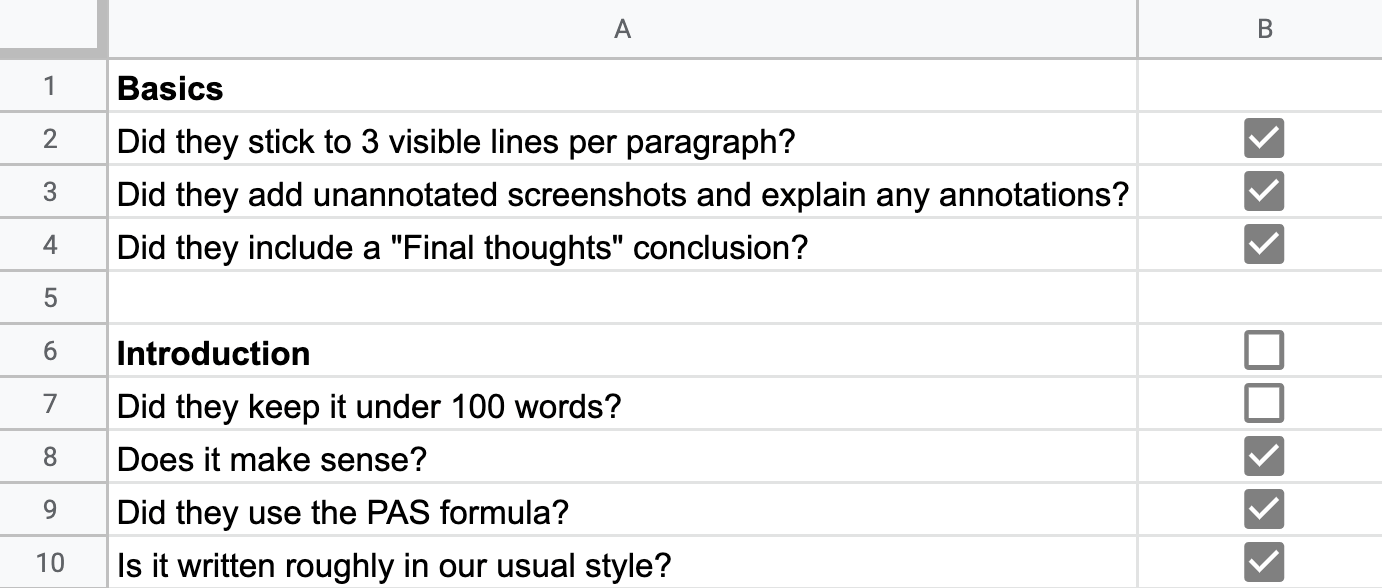
You can see that we check the article as a whole for a few basics, then review each section in more depth.
For example, here are a few of our criteria for the definition:
- Is it written in the correct format (according to our guidelines)?
- Is it accurate?
- Is it well written?
In total, there are 30 things on our checklist. Each one equals one point, so we score each applicant out of 30.
Hiring is the easy part. If an applicant scores well on their test article, we assign them an actual one to write. If that goes well, we give them more.
Here are a few things to look out for when working with freelancers:
- Quality deterioration – Freelancers can sometimes get lazy or even begin subcontracting work. Both of these things lead to a reduction in quality.
- Reliability issues – Life occasionally gets in the way for everyone but watch out for consistent unreliability.
- Communication issues – For whatever reason, disappearing off the face of the earth is surprisingly common.
Don’t hesitate to drop writers if you face these issues. Continuing to work with them will suck your time and energy.
By that same token, when you come across reliable freelancers who consistently produce high-quality work, treat them well. Great writers are worth their weight in gold, so keep giving them work and review their rates periodically.
Final thoughts
Hiring freelance writers is easy when you have a system in place. You can even automate many of the steps with tools like Zapier.
For example, we have zaps for outline requests, logging details, and sending payment requests to our office manager.
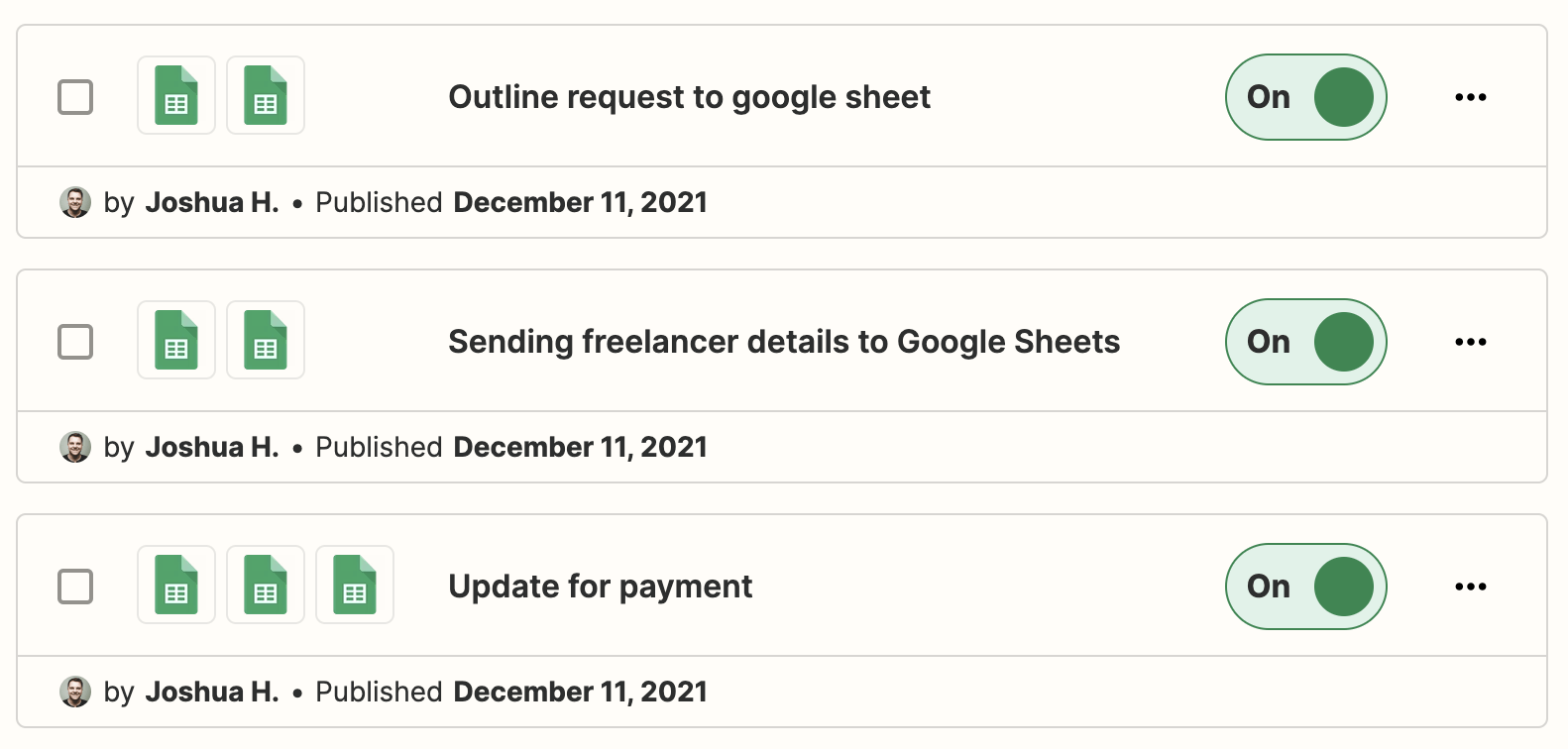
Got questions? Ping me on Twitter.




